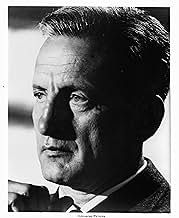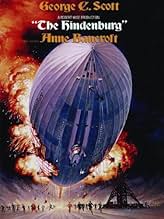VALUTAZIONE IMDb
6,3/10
6748
LA TUA VALUTAZIONE
Segui gli eventi del disastro di Hindenburg in cui uno zeppelin ha preso fuoco.Segui gli eventi del disastro di Hindenburg in cui uno zeppelin ha preso fuoco.Segui gli eventi del disastro di Hindenburg in cui uno zeppelin ha preso fuoco.
- Candidato a 3 Oscar
- 2 vittorie e 4 candidature totali
Richard Dysart
- Captain Ernst Lehman
- (as Richard A. Dysart)
Trama
Lo sapevi?
- QuizThe actual site of the Hindenburg crash, at Lakehurst Naval Air Station (now part of Joint Base Lakehurst-Dix-McGuire) is marked with a chain-outlined pad and bronze plaque where the airship's gondola landed. It was dedicated on May 6, 1987, the 50th anniversary of the disaster. Hangar #1, which still stands, is where the airship was to be housed after landing. It was designated a National Historic Landmark in 1968.
- BlooperThe incident depicting the Hindenburg's crew repairing the tear in the Zeppelin's cover as it drifts lower and lower over the Atlantic is factual; however, the event occurred on the Graf Zeppelin, not the Hindenburg.
- Citazioni
Mrs. Channing: Sugar, next time, let's take the Titanic.
- Curiosità sui creditiThe film opens with the 1936 Universal logo followed by a newsreel prior to the credits.
- Versioni alternativeDeleted scenes were added back into the film for television airings, including one in which Goebbels shows Ritter a display of items used in attempted anti-Nazi attacks, including a bomb found on board the ocean liner "Bremen".
- ConnessioniEdited into I predatori dell'arca perduta (1981)
- Colonne sonoreThere's a Lot To Be Said for the Fuehrer
Music by David Shire
Lyric by Ed Kleban (as Edward Kleban)
Performed by Peter Donat (uncredited), Robert Clary (uncredited)
Recensione in evidenza
The 1970's were the age of the disaster films. Films featuring man made and natural calamaties with flashy special effects and big name stars were the "in" thing back then. Irwin Allen was the master of these when he made The Posiedon Adventure and The Towering Inferno. Jennings Lang also made an epic disaster film with Earthquake. In 1975, Robert Wise got into the act with The Hindenburg. Wise is one of our finest directors and I was so happy when he won the American Film Institute's Lifetime Achievement Award several years ago. Everyone loves a good mystery and the Hindenburg disaster is certainly one of them. What caused the explosion? We will probably never know. What we do know is that politics had a lot to do with it. The Hindenburg was filled with volatile hydrogen gas instead of helium. Helium is so safe it would actually smother fire. The American government did not wish to give the Germans helium because they feared they would use it for military purposes. This film has a first class cast with George C. Scott leading the way as the heroic Colonel Franz Ritter. Only a fine actor like Scott could have made a Nazi likeable. There are so many other fine thespians in the cast like Anne Bancroft and Charles Durning (as the Captain). A very fine character actor named William Atherton is the rigger who plants the bomb. Wise is a master of suspense because we all know what is going to happen and the ship is going to blow up, and yet you are on the edge of your seat as Ritter desperately races time to find the bomb. I would also like to mention how much I enjoyed Wise's masterful use of actual film footage of the disaster which he intermingles with scenes of the various actors trying to escape the burning ship. One of the fun things about these disaster films is watching who lived and who died at the end (what is really funny is that those near the top of the cast usually lived the longest!). There was indeed a theory that a rigger on the airship named Eric Spehl (they called him Karl Boerth in the movie) had indeed sabotaged the Hindenburg. The surviving crew members said that they had heard a sudden pop over their heads and looked up to see a circle of bright light that looked like a flashbulb igniting. It was near the axial gangway and this rigger was one of only a few who had acess to it. Spehl was known to have anti Nazi views. Did he plant a bomb? The theory is that Spehl had timed his explosive device (really a flashbulb attached to a photographic timer) to go off after the airship had landed. But the landing was delayed by a storm and he could not get back in time to re set it. Spehl was killed in the disaster and thus we will never know. The most chilling part of this film is where they play Herb Morrisons recording. He was the WLS Chicago reporter who was there to witness a routine airship landing and instead it was one of the most famous recordings ever made. Morrison lived until 1988 and resided near my home in West Virginia.
I più visti
Accedi per valutare e creare un elenco di titoli salvati per ottenere consigli personalizzati
- How long is The Hindenburg?Powered by Alexa
Dettagli
- Data di uscita
- Paese di origine
- Lingua
- Celebre anche come
- The Hindenburg
- Luoghi delle riprese
- Marine Corps Air Station Tustin, Tustin, California, Stati Uniti(used for Naval Air Station Lakehurst - airship hangers still standing in 2022)
- Azienda produttrice
- Vedi altri crediti dell’azienda su IMDbPro
Botteghino
- Budget
- 15.000.000 USD (previsto)
- Tempo di esecuzione2 ore 5 minuti
- Colore
- Proporzioni
- 2.35 : 1
Contribuisci a questa pagina
Suggerisci una modifica o aggiungi i contenuti mancanti

Divario superiore
By what name was Hindenburg (1975) officially released in India in English?
Rispondi




































